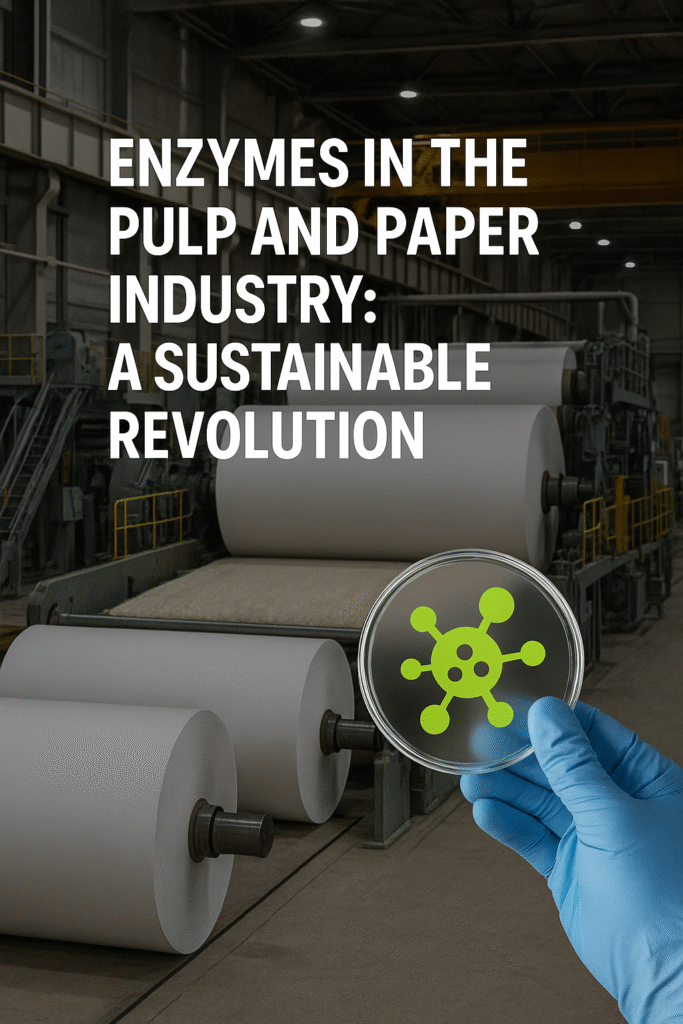
The pulp and paper industry is essential, providing everyday products like books, packaging, and stationery. However, traditional paper manufacturing consumes vast amounts of water, energy, and harsh chemicals, raising environmental concerns. To address this, the industry is turning to enzymes—natural biocatalysts that enhance efficiency, reduce waste, and support eco-friendly production.
Table of Contents
- Enzymes: Nature’s Catalysts for Sustainable Papermaking
- Key Enzymes in Pulp & Paper Processing
- Why Enzymes Are Transforming the Industry
- Applications of Enzymes in Paper Manufacturing
- Benefits of Enzyme-Based Processing
- Challenges in Enzyme Adoption
- Leading Enzyme Suppliers in India
- Future Trends in Enzymatic Paper Production
- Conclusion: A Greener Path Forward
1. Enzymes: Nature’s Catalysts for Sustainable Papermaking
Enzymes are specialized proteins that accelerate biochemical reactions without being consumed. In pulp and paper manufacturing, they:
- Speed up processes without excessive energy input.
- Reduce reliance on toxic chemicals, lowering environmental harm.
- Enhance paper quality, making it stronger, brighter, and more recyclable.
By integrating enzymes, manufacturers can achieve cleaner, more efficient, and cost-effective production.
2. Key Enzymes in Pulp & Paper Processing
Cellulase: Strengthening Fibers
Breaks down cellulose fibers in wood and recycled paper, improving flexibility and processing efficiency. Also aids in deinking recycled paper.
Xylanase: Brightening Pulp Naturally
Targets xylan, a hemicellulose in plant cell walls, reducing the need for chlorine-based bleaching. Results in whiter, smoother paper with fewer pollutants.
Laccase: Lignin Removal for Cleaner Pulp
Degrades lignin, the rigid polymer in wood, facilitating easier bleaching and reducing chemical use.
Lipase: Preventing Sticky Residues
Breaks down lipids and resins in recycled paper, preventing machine clogging and improving operational efficiency.
3. Why Enzymes Are Transforming the Industry
- Reduced Chemical Use – Less pollution and fewer hazardous byproducts.
- Energy & Cost Savings – Lower processing temperatures and faster reactions.
- Higher-Quality Paper – Improved brightness, strength, and recyclability.
- Eco-Friendly Production – Supports sustainable manufacturing practices.
4. Applications of Enzymes in Paper Manufacturing
Pulp Preparation
- Cellulase & Xylanase soften fibers, reducing mechanical refining needs.
- Enzymes cut energy consumption and improve pulp uniformity.
Bleaching & Brightening
- Laccase & Xylanase replace chlorine-based bleaching, producing whiter pulp with fewer toxins.
Recycling & Deinking
- Cellulase & Lipase remove ink and adhesives, enhancing recycled paper quality.
Fiber Enhancement
- Enzymes strengthen fibers, leading to more durable, high-performance paper.
5. Benefits of Enzyme-Based Processing
✔ Cleaner Operations – Fewer toxic emissions and wastewater pollutants.
✔ Lower Costs – Reduced energy, water, and chemical expenses.
✔ Superior Product Quality – Smoother, brighter, and more resilient paper.
✔ Regulatory Compliance – Helps meet stricter environmental laws.
6. Challenges in Enzyme Adoption
Despite their advantages, enzyme applications face hurdles:
- Sensitivity to Conditions – Require precise pH and temperature control.
- High Initial Investment – Transitioning to enzyme-based systems can be costly.
- Industry Resistance – Some manufacturers hesitate to shift from traditional methods.
7. Leading Enzyme Suppliers in India
India is home to several enzyme producers supporting sustainable papermaking. Ultrez Enzymes Pvt Ltd is a key player, offering specialized enzymes that enhance efficiency and reduce environmental impact.
8. Future Trends in Enzymatic Paper Production
🔹 Advanced Enzyme Engineering – Developing heat-resistant and faster-acting enzymes.
🔹 Stricter Environmental Regulations – Driving more companies toward enzymatic solutions.
🔹 Growing Demand for Green Products – Consumers prefer eco-friendly paper, boosting enzyme adoption.
9. Conclusion: A Greener Path Forward
Enzymes are revolutionizing the pulp and paper industry by making production cleaner, more efficient, and sustainable. While challenges remain, ongoing research and technological advancements promise a future where high-quality paper is made with minimal environmental impact.
By embracing enzyme technology, the industry can meet global sustainability goals while delivering superior products—proving that innovation and ecology can go hand in hand.
Final Thought:
The future of paper isn’t just about what we write on—it’s about how we preserve the planet while making it.